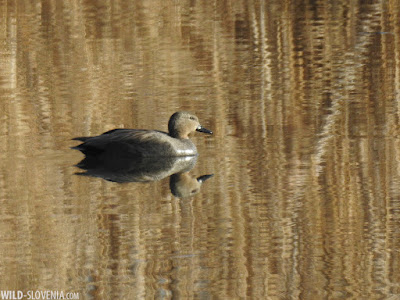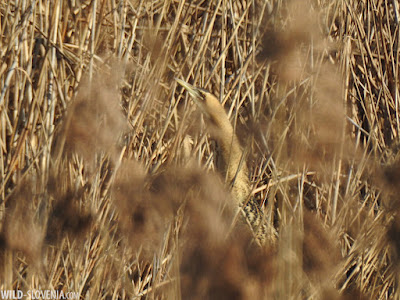We stepped into 2022 by doing what we do most of the other time of the year: birding. This time we took advantage of the few festive days around New Year (actually a long weekend) to visit Slovenia's birding hotspot - the wetlands in the Štajerska region (NE Slovenia), where the Pannonian plain begins. This is an area we visit a couple of times every year, but especially so in winter, when the Drava river attracts large numbers of waterbirds (surely the largest wildfowl flocks in the country). Therefore it is no surprise that the region acts as a magnet also for Slovenian birders (see our friends'
blog).
But first we'll step back a bit, because our New Year's tour of eastern Slovenia began on the last day of 2021, in the lowland alluvial forest of Krakovo (Krakovski gozd, east of Novo Mesto). We had some fieldwork there which included measuring trees and other parameters in the habitat of Middle Spotted Woodpecker Leiopicus medius for an ongoing study that Sara is carrying out. It is always great to return to this primeval lowland forest and marvel at the diameters and heights of its centenary oaks. Speaking about birds, the situation was rather quiet, as it is typical for mid-winter. However we couldn't leave the forest without our dose of Middle Spotted Woodpeckers (Krakovski gozd is the Slovenian stronghold of the species) - we heard/seen at least 5. Other interesting birds included 2 Black Woodpeckers Dryocopus martius and several Treecreepers Certhia familiaris. As we were driving away at twilight, we spotted our last bird of the year - a Ural Owl Strix uralensis hunting on the edge of the forest! What a better rounding up of a year filled with Ural Owls?

 |
Krakovski gozd - lowland alluvial forest.
|
 |
Pedunculate Oak Quercus robur is the forest's most characteristic tree.
|
 |
Neither Krakovski gozd is immune to intensive logging.
|
 |
The central, old-growth part of Krakovski gozd - a forest reserve.
|
 |
Middle Spotted Woodpecker Leiopicus medius, preening.
|
 |
Amazing tree diameters in the old-growth forest, where Middle Spot densities are the highest.
|
 |
Measuring DBH (diameter at breast height) of some large oaks.
|
 |
A cup of tea in the flooded forest.
|
The next morning, freshly into 2022, we were already birding along the river Drava. First of all we checked the artificial lake of Ormož, on the border with Croatia, where a Long-tailed Duck Clangula hyemalis was reported earlier in the week. We searched hard for this (almost annual) rarity from northern Europe, but without success. However there were lots of other interesting species to keep us entertained. The lake was covered by literally hundreds of Tufted Ducks Aythya fuligula, Pochards Aythya ferina and Goldeneyes Bucephala clangula, among which there were also at least 11 Smews Mergellus albellus (an increasingly scarcer winter visitor to Slovenia), several Goosanders Mergus merganser, 6 Velvet Scoters Melanitta fusca and many other commoner waterbirds.
 |
Birding on the artificial bank of the Ormož lake.
|
 |
The Ormož lake is an artificial reservoir on the river Drava.
|
 |
Smew Mergellus albellus - 2 of the at least 5 beautiful drakes.
|
Next it was the turn for a visit at the nearby Ormož Basins Nature Reserve (Ormoške lagune), a system of disused artificial pools created by the ex Ormož sugar factory. The site, now an important waterbird nesting & migration stopover area, is under the management of DOPPS-BirdLife Slovenia. Apart from birds, there are also Otters Lutra lutra & Beavers Castor fiber roaming the reserve, the former being also regularly observed by the reserve's staff (we came across its footprints). In winter the site might look rather calm at first, but as we took our time to work it properly, we managed to see several interesting species. In the vast stands of reedbed we managed to observe the elusive Bittern Botaurus stellaris, as well as flocks of Penduline Tits Remiz pendulinus and Reed Buntings Emberiza schoeniclus, while the much rarer Bearded Tits Panurus biarmicus wintering there eluded us. Among other waterbirds there were also good numbers of Pygmy Cormorants Microcarbo pygmaeus, Gadwalls Mareca strepera and several Water Rails Rallus aquaticus (one seen). At around midday a large raptor glided in the sky above the reserve - it was an immature White-tailed Eagle Haliaeetus albicilla, moving slowly upriver along the nearby Drava. Later a flock of around 70 White-fronted Geese Anser albifrons passed overhead and only after photographing them and checking the photos, we noticed there were two Tundra Bean Geese Anser fabalis rossicus within the flock! Bean Geese have become real rarities in the last decades in Slovenia (as well as the whole Northern Adriatic region), despite once being the most numerous wintering geese.
 |
Reedbed in the Ormož basins.
|
 |
Bittern Botaurus stellaris
|
 |
Penduline Tit Remiz pendulinus
|
 |
Bulrush Typha spp.
|
 |
Gadwall Mareca strepera
|
 |
Pygmy Cormorant Microcarbo pygmaeus
|
 |
White-tailed Eagle Haliaeetus albicilla
|
 |
Tundra Bean Geese Anser fabalis rossicus among White-fronted Geese Anser albifrons
|
 |
Wet meadows grazed by water buffalos.
|
 |
Water buffalos
|
 |
Footprint of Otter Lutra lutra on the path in the Ormož basins Nature Reserve
|
In the afternoon as we were leaving the Ormož Basins Reserve we also spotted a flying flock of around 10 Rooks Corvus frugilegus, another increasingly scarce winter visitor to Slovenia. Upon advice from our friend and colleague Luka Božič, in the small town of Ormož we checked some conifers for roosting Long-eared Owls Asio otus. At first it was rather hard to spot them in the thick canopy, but after a while, at least 5 owl shapes appeared. Living in hilly western Slovenia, we are not used to see this rather common lowland species, so it is always a pleasure to observe them on a winter daytime roost.
 |
Long-eared Owl Asio otus at daytime roost
|
Before calling it a day we stopped on the southern shores of the lake of Ptuj, another artificial reservoir on the river Drava. Here the waterbirds were mostly the same as those on Ormož, except for some larger numbers of Goosanders Mergus merganser and a few other goodies like 3 Slavonian Grebes Podiceps auritus and at least 6 Velvet Scoters Melanitta fusca, while other observers also found 2 Red-throated Divers Gavia stellata.
 |
The artificial lake of Ptuj.
|
 |
Ptuj's castle on the northern shores of the lake.
|
 |
Velvet Scoter Melanitta fusca
|
 |
Slavonian Grebe Podiceps auritus
|
 |
Tufted Duck Aythya fuligula
|
 |
Sunset in Ptuj near the Drava with the mountains of Boč and Donačka gora in the distance.
|
 |
Dravsko polje (the Drava plain) and the Pohorje plateau in the background.
|
The next day we decided to visit some wetlands in the area between Ptuj and Slovenska Bistrica, away from the river Drava. The first stop was at a rather large gravel pit called "Green Lake" near Kidričevo, where a flock of around 80 Pochards Aythya ferina also contained 4 Greater Scaups Aythya marila, a species we haven't seen in ages! It was nice to catch up with a male and 3 females of this (yet another) increasingly rare winter visitor that used to be commoner about until a decade ago. Nearby we were also greeted by a flock of 6 male Red-crested Pochards Netta rufina, another rare bird in Slovenia. While watching the wildfowl, we heard some pecking on the poplars overhead - it was a female Lesser Spotted Woodpecker Dryobates minor, while from the Kidričevo forest we also heard a Black Woodpecker Dryocopus martius. In the open fields nearby we added a Great Grey Shrike Lanius excubitor to the list.
 |
Greater Scaup Aythya marila
|
 |
| Red-crested Pochard Netta rufina (including a romantic shot) |
 |
Lesser Spotted Woodpecker Dryobates minor
|
Then it was time to check the lovely fishponds near Rače, where there's usually something interesting to see. The water bodies were full of ducks, but almost all were either Gadwall Mareca strepera or Mallard Anas platyrhynchos. The real surprise came when we were walking on the main road through the fishponds and Sara spotted a flock of Bearded Tits Panurus biarmicus feeding on the bulrush (Typha sp.) only a few metres away from us. The flock numbered 5 birds (3 males and 2 females) and for a good half hour allowed some of the best views we ever had of this species! Meanwhile dog walkers and nosiy families were passing by only a couple of metres from the Bearded Tits, but the birds didn't seem to be bothered too much. In the stands of bulrush we were also surprised to see a Firecrest Regulus ignicapillus. By one of the fishponds we also came across a dead Polecat Mustela putorius, probably the victim of the local road.
 |
One of the fishponds at Rače.
|
 |
Bearded Tit Panurus biarmicus - we couldn't have enough of them!
|
Shaky video of a male Bearded Tit feeding on bulrush Typha.
 |
Bulrush Typha savaged by Bearded Tits.
|
 |
Polecat Mustela putorius, an uncommon mustelid in Slovenia.
|
Last call of the day was the famous reservoir/fishpond of Medvedce near Pragersko, were we found similar wildfowl species to the other locations we visited previously; only Goosanders Mergus merganser seemed to be slightly more numerous here. There was also a large flock (1-2 thousands?) of Greylag Anser anser and White-fronted Geese Anser albifrons, while in the farmlands around the reservoir we were glad to observe a small group of 6 Stock Doves Columba oenas (a species virtually absent in western Slovenia) and a male Hen Harrier Circus cyaneus.
All in all not a bad start of the year!




























































